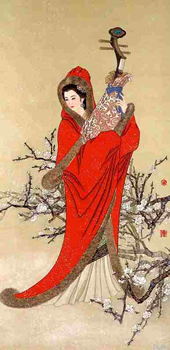 |
|
Wang Zhaojun on her way to Xiong-Nu. |
Wang Zhaojun was one of
the four China’s ancient beauties. Like her peers, her fame was also tied
to the political development of her time. Today, the name of Zhaojun not only
symbolizes physical beauty, but also a spirit of goodwill to bridge different
cultures, even at the expense of one’s own interests.
During the reign of the
Han emperor Xuan (91-49BC), the Huns, or Xiong-Nu (http://www.wikipedia.org/wiki/Hun),
Han’s troublesome northern neighbor, split into five kingdoms, each led
by a chieftain known as Shan-Yu. Wars started among the five Shan-Yus in a bid
for control. Shan-Yu Khukhenye, who was defeated by his brother Shan-Yu Zhizhi-Guduhu,
decided to befriend the former foe in the south, Emperor Xuan, by suggesting
that he pay the emperor a personal visit. Khukhenye was the first
Shan-Yu that ever came to pay tribute to a Han emperor. Rejoiced and feeling
a bit flattered, Emperor Xuan went out of his way to meet Khukhenye at the suburb
of Capital Chang’an and held a grand banquet in his honor. After a month’s
stay in Chang’an, Khukhenye thought of going back home and asked Emperor
Xuan for help. The emperor sent an army of ten thousand strong to escort him
back and gave him a hundred thousand bushels of food to bring back to his starved
people. The thankful Khukhenye was determined to maitain the friendly relationship
with the Han Dynasty.
 |
| Wang Zhaojun
in Xiong Nu |
After Emperor
Xuan’s death, his son succeeded the throne and became Emperor Yuan. Meanwhile,
Shan-Yu Zhizhi-Guduhu had been running over the states to the west of Han and
went so far as to slay the envoy of the Han emperor. This act of brutality incurred
the emperor’s relaliation and cost his own life. With the death of Shan-Yu
Zhizhi-Guduhu, Khukhenye’s position was further strengthened. In the year
of 33AD, he paid a second visit to the Han’s capital, where he asked to
marry one of Emperor Yuan’s daughters to cement the relations of Han and
his Xiong-Nu state. The emperor granted his request, but instead of his daughter,
the bride would be a maid of honor. Getting married would be a god-sent opportunity
for a maid of honor to be freed from their perpetual solitude in the backyard
of the palace. However, all but one volunteered to venture in to a matrimony
that would destine their life in a foreign land. That was Wang Qiang, better
known in history as Wang Zhaojun. She was extremely beautiful and intelligent.
At the wedding in Chang’an, the emperor was awed by Zhaojun’s beauty.
Back to his chamber, Emperor
Yuan was very regretful that he allowed Wang Zhaojun to be married to the Xiong-Nu
chiefttain. He would have had her as his concubine if he had known she was so
glamorous. He wondered why he had not seen her portrait and sent for it for
a review. Incidentally, emperors chose their concubines by looking at portraits
instead of the girls themselves. When he found that the portrait did not match
Wang Zhaojun, he launched an investigation. It turned out that the artist Mao
Yanshou would paint a prettier portrait for those who bribed him or vice versa.
As Wang Zhaojun refused to do so, he did injustice to her beauty so that the
emperor would never know her existence in the palace. In rage, Emperor Yuan
had Mao Yanshou executed. Regretful as he was, Emperor
Yuan blessed the inter-racial marriage. He admired Zhaojun’s courage and
was thankful for her willingness to serve the interests of Han in spite of her
own.
Escorted by officials sent
by the emperor, Wang Zhaojun embarked on a long journey to the north on horseback.
They braved bitter cold and heavy snow storms and finally reached Xiong-Nu.
There Khukhenye conferred the title of Peaceful Hu-E-Shi, in the hope that she
would bring them security and peach. That she did by persuading Khukhenye to
abandon violence. As a result, peace reigned on the border with her mother country
for over half a century. After Khukhenye’s death, Zhaojun married the
eldest son of his and his concubine in accordance with the custom of the Xiong-Nu
nationality – a custom abhored by the Chinese moral norms in which she
was brought up. Therefore, it must have taken a lot of courage and political
insight for her to do so. It has been popularly believed that she did so for
the sake of Xiong-Nu’s stability, and thereby peace between Xiong Nu and
her mother country. For her self-sacrifice a second time, she earned the respect
of her compatriots not only in her generation, but generations to come.
Text and translation
by Haiwang Yuan, © copyright 2003
Last update: October 3, 2003
|